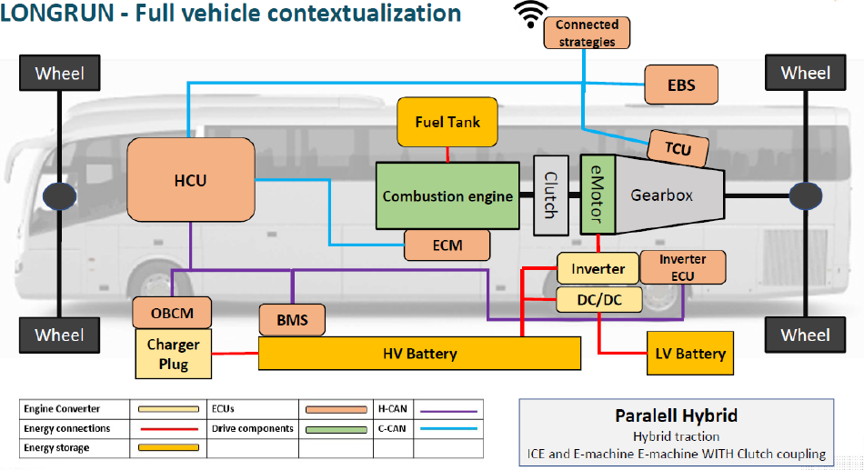Due to a good compromise among Fuel economy, CO2 emissions and powertrain integration complexity (which have direct impact on TCO), parallel hybrid powertrain topologies are currently a suitable HEV solution for long-distance heavy-duty applications, in terms of fuel economy and complexity.
For many manufacturers the parallel hybrid architecture has been the powertrain of choice for their first step into vehicle electrification. The parallel architecture consists of an electric machine placed in line with the ICE. It is referred to as a parallel configuration because the power is added up from both the ICE and the electric machine to the transmission independent of each other. The electronic control selects the engine operation point (torque vs engine speed) to minimize fuel consumption depending on the state of charge of the batteries and the vehicle power demand.
Figure 1: Parallel hybrid powertrains configurations
The power transmission from the electric motor to the gearbox ensures greater energy savings compared to other systems like hydrostatic hybrid transmissions (in which the energy can be saved in a compressed air reservoir). The electric motor could act as a power unit to charge the batteries, while the vehicle is slowing down/stopping.
Different control strategies are used in a preferred approach. If the power required by the driver is higher than the output power of the ICE, the electric motor is turned on so that both engines can supply power to the transmission. If the power required by the transmission is less than the output power of the ICE, the remaining power is used to charge the battery packs. Moreover, mechanical and electric power could be decoupled, and the system has a high operating flexibility enabling three modes of operation: purely combustion; purely electric and hybrid. Usually, a PHEVs are managed in purely electric mode at low speeds, until the battery charge state reaches a predetermined low threshold, typically around 20%.
P2 architecture is likely to be the dominant strong hybrid technology, based on projected cost and effectiveness.
Besides there are three important factors to choose P2 topology as the final one:
- An optimum Gradeability
- Performance combined with ICE downsizing
- Easier integration with brake system compared to a P4 , “add-on solution” vs additional gearbox an decoupled power source.
Below, please find the LONGRUN- Full Vehicle contextualization. Irizar will integrate a dedicated Hybrid Control Unit, the Irizar´s Hybrid Control Module
IRIZAR’s objectives in LONGRUN are
- To achieve a 10% energy savings (compared to i6s 2018 reference vehicle) demonstrated in a fully functional vehicle, by:
- Optimization of hybridization (2.5%).
- Smart hybrid control architecture (customized HCM) (3.0%).
- Smart auxiliaries (2.5%).
- Innovative solutions for connected vehicle (2%).
- To achieve 10% reduction of CO2 emissions related to energy savings, apart from the use of HVO alternative fuel.
To reduce GHG emissions and contribute to the project´s objectives, IRIZAR develops a Hybrid vehicle with State of the Art (SotA) Internal Combustion Engine (ICE) fueled with Hydrotreated Vegetable Oil (HVO), incorporating advanced Hybrid Control Module (HCM) and smart Heating, Ventilation and Air Conditioning (HVAC) system. The proposed development will aim to achieve a 12% energy savings when compared to the i6s 2018 reference vehicle, which directly brings 12% of CO2 reduction.


